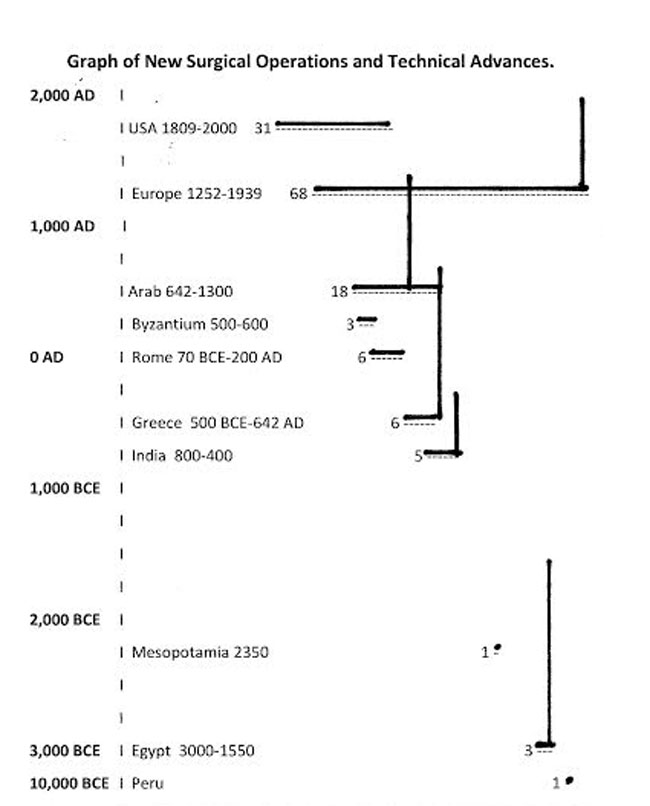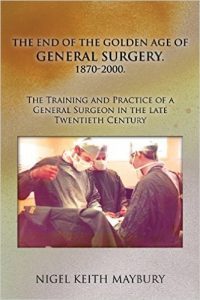FIRST ANALYSIS OF THE TIMELINES OF SURGERY
The graph below shows the civilisation and approximate date in which novel operations are recorded to have been first performed, this may well need corrections and updates. It is not possible to show the new, better and safer techniques of carrying out operations over the years, as the graph is designed to show the genius or serendipity of the originators of these operations.

Numbers on the right (in a diagonal line) show the number of new operations and significant technical advances applicable to surgery in each civilisation. The vertical lines show overlaps in advances over the centuries and is particularly applicable with the exchange of knowledge and ideas between the ancient civilisations to the present. These include the Egyptians, Hindus, Greeks, Romans, Byzantines, Arabs, Europeans and finally the Americans.
This diagram does not include medicine and pharmacology in which the early civilisations made significant advances. The most useful of the few drugs available in surgery before anaesthesia, in 1846, was opium which may have been available from Greece from about 1250 BCE and used to deaden the excruciating pain that surgery caused patients. The diagram is complex and where there are obvious gaps this indicates that there were no known new operations during this time. Any further information would be welcome.
Breakdown and Distribution of New Surgical Procedures and Technological Advances among the Nations of Europe.
Russia is included as part of Europe for this surgical innovation and both Australia and South Africa were formerly part of the British Empire.
| Country | Number | Years of innovation |
| Italy, Spain and Portugal | 4 | 1597-1624 |
| France | 12 | 1252-1862 |
| Germany & Austria | 16 | 1610-1909 |
| UK | 31 | 1540-1987 |
| Netherlands | 2 | 1683-1755 |
| Russia | 1 | 1901 |
| Australia | 1 | 1982 |
| South Africa | 1 | 1967 |
Second Analysis of the timeline of general surgery.
The first analysis of the Time Line of General Surgery (see above) looked at the flow of innovation in surgery in the past. As the dates show there was considerable exchange of information over the millennia. Historians and archaeologists have shown that all of these empires and cultures were interconnected by travellers, trade and the exchange of knowledge. This exchange and cooperation has accelerated in modern times. The inter-connectivity and availability of advances in learning is due, not only to journals and the internet, but also to meetings and conferences with colleagues. Some innovations in surgery in the past may have been lost and then reinvented at a later date, but the main picture is of a continuum of knowledge. Resulting in increasing sophistication of surgical operations over time, being brought about by ingenious people who then and now, applied and apply new discoveries in science and technology to their craft. These discoveries and advances, often piecemeal and initially slow, include anatomy, physiology, pathology, metallurgy, chemistry, pharmacology, radiation and xrays, electricity, chemotherapy and genetics.
This second analysis shows the acceleration of learning over time irrespective of by whom the discoveries were made, but all confirming the ingenuity of homo sapiens at its best.
Table of each first description of a new operation as described in the archaeology and literature since earliest times.
| 10,000 BCE | 1 | 1 |
| 4000-3001 BCE | 1 | 1 |
| 3000-2001 BCE | 1 | 1 |
| 2000-1001 BCE | 0 | 0 |
| 1000-1 BCE | 11111 | 5 |
| 0-499 ADE | 111111 | 6 |
| 500-999 AD | 11111 | 5 |
| 1000-1499 AD | 11111 | 5 |
| 1500-1849 AD | 111 | 3 |
| 1850-1899 AD | 1111111111111111111111111 | 25 |
| 1900-1949 AD | 1111111111111 | 13 |
| 1950-1999 AD | 11111111 | 8 |
The Table above, is of course imperfect, and must be considered a work in progress to be altered and expanded as necessary. It shows the dates when totally new operations have been added and does not list the improvements in operating methods and techniques that have taken place in modern surgery.
One example shows that the earliest operation known is that of craniotomy, going back to at least 10,000 BCE. Examples of this early operation have been found all over the world. In his excellent book, ‘The healing hand, man and wound in the ancient world’, Guido Majno (1) notes, ‘that these are the oldest traces of a surgical act’ that was still being practised in remote parts of North Africa as late as the 19th century. An observer, of such an operation at this later date, observed that the ‘dura mater’, the tough membrane protecting the brain within the skull, was never opened deliberately as death would occur. Presumably due to infection. So, an operation performed in 10,000 BCE represents the first operation on the skull. Then separately recorded in the Time Line in 1879 was John Thudichum’s, resection of a meningioma, listed because it was the first elective operation on the brain.
A second example, concerns inguinal (groin) hernia repair in the mid-eleventh century in Muslim Spain (2). In the following centuries, there have been many techniques for doing this operation, but the recurrence rate did not decline to about 1-2% until the latter part of the 20th century, when a mesh was developed and used to reinforce the inguinal canal. This can be carried out either through an inguinal incision or at laparoscopy. The structure of the mesh now used is important, because the threads are monofilament and smooth and therefore leave no nooks or crannies in which bacteria can secrete themselves and multiply, while being out of reach of antibiotics. Before this material was developed meshes often became an infected foreign body, causing a chronic abscess (3) as occurred when silk was used to reinforce many hernia repairs in the first half of the twentieth century. The author has experience of operating to remove the infected silk from chronically infected groins while he was a surgical registrar at Warwick Hospital in England. These latter procedures are not included as the Time Line was designed to show the dates at which each operation or procedure was first invented.
The initial pace of discoveries was glacial. From 10,000 BCE to the beginning of the 2nd millennium BCE, a period of nine thousand years there were three operations described. The next 1000 years, comprising the years 1000 BCE to the beginning of the Christian era, witnessed sophisticated Hindu operations with at least five novel procedures, including two plastic surgery operations. The pace then quickens in the next half millennium 0-499 AD with six procedures. This same pace is essentially maintained for the next three half millennia. Then in the period 1500-1849 the pace has slowed. However, during the following fifty years from 1850-1899 there were 25 new operations, an explosion of new operations, resulting from the introduction of ether in 1846. Ether was first used in the USA and from there the use of ether as an anaesthetic spread immediately to Europe and on to much of the world including the colonial possessions of that time. With general anaesthesia, the great cavities of the body, the cranium, the thorax and the abdomen could be entered for planned complex operations on all the organs therein. But wait, in the next two half- centuries, 1900-1949 and 1950-1999 the rate of new operations fell to 13 and then 8. What was happening?
Nowadays all the operations listed in the Time Line are within the surgeon’s ambit. Of course, the operations are now modified and with the use of modern instrumentation, such as enables a laparoscopic entry to the abdomen. This approach still enables the surgeon to carried out essentially the same operation as that originally listed in the Time Line. The laparoscopic approach is of great benefit to the patient, as the trauma of entry to the abdominal cavity is significantly reduced, minimising pain and enabling many patients to be treated as day cases, rather than a hospital stay. Then there are more examples of reconstructive surgery in suitable cases. An example of this is when an organ, such as the stomach has been totally excised for cancer, the surgeon can then fashion a pouch out of small bowel, to be attached to the oesophagus to replace the excised stomach. Similarly, a patient’s rectum which has had to be excised due to severe unremitting ulcerative colitis can now be replaced with a pouch formed from one or more loops of small bowel to provide a reservoir ((3) Table 10).
Following the clinical advent of radiotherapy in 1946 and chemotherapy in 1951, these treatments have now advanced as witnessed by the widespread use of radiotherapy and chemotherapy in treating some cancers. For example, up until the 1980s, patients with cancer of the anus usually underwent an excision of the anus and rectum to clear the tumour. Although this was usually curative, it meant that the patient would have a permanent colostomy. The drastic operation described above is now only needed in the very few patients who have the misfortune of a recurrence of the cancer after radio and chemotherapy. Because of the effectiveness of these non-surgical treatments, a major surgical procedure is now rare. It would seem that there will be a continued decline in surgery for cancer that will be welcomed by patients. This decline was predicted by Sir Peter Bell, the Foundation Professor of Surgery at the University of Leicester in 1975, under whose tutelage the author had the pleasure of being in his department, as a lecturer of surgery in the late 1970s (4).
References: (1). The healing Hand, Man and Wound in the Ancient World by Guido Majno. Published by Harvard University Press 1991. (2). Medieval Islamic Medicine by P.E. Pormann & Emile Savage-Smith. Edinburgh University Press 2010. (3) The End of the Golden Age of general Surgery. The training and practice of a general surgeon in the late twentieth century By Nigel Keith Maybury. Publisher Createspace, 2014. Available on Amazon. (4). The Changing Face of Surgery. An Inaugural Lecture by P.R.F. Bell Leicester University Press, 1975.
The End of the Golden age of General Surgery. 1870-2000. The Training and Practice of a General Surgeon in the late Twentieth Century

£9.54 from Amazon
